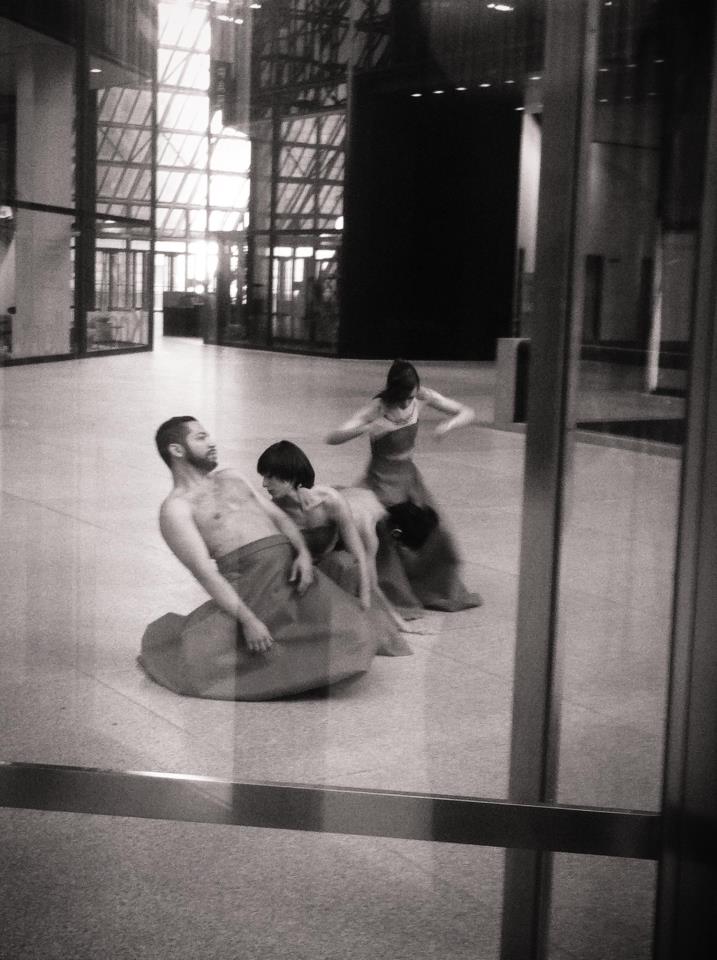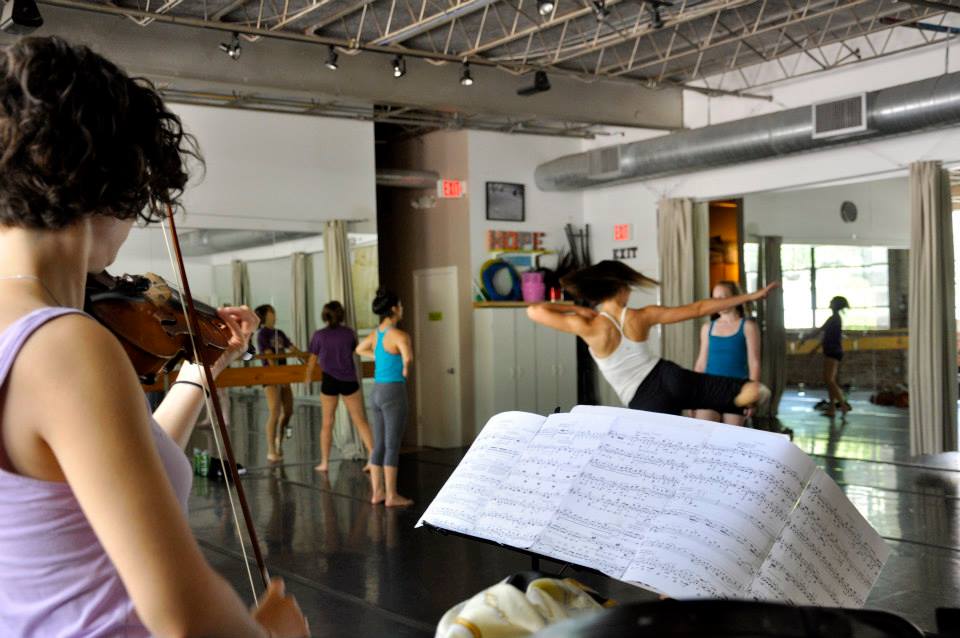Learning to Listen: Frame Dance Productions’ Ecouter

Photo by Jonathan Hance
There is a moment in Quiver, Frame Dance Productions’ latest dance-on-film, when four dancers reach their arms upwards, throats open, and turn around themselves in exquisite floor-length blue skirts. The quartet gives the impression of a contemporary American, twenty-first century interpretation of a whirling dervish. Quiver is made up of striking, pristine images accompanied by a haunting score by Mark Hirsch. The audience was all eyes and ears, making it a strong choice for the opener to the evening-length program Ecouter.
Frame Dance Productions is not a narrative-based company, but I think there is an implied story in Quiver. The quartet melts into itself, each dancer reacting to other’s touch. They recoil and pulse, limbs reaching and curling into themselves. The movement gives life to the sanitized, almost sterile Pennzoil Place. The reflecting glass and longshots of the dancers inside and outside the building suggest the psychology of the office workers who inhabit this space for nine hours of the day. The trembling close-ups imply a frustrated psyche conditioned to internal trauma; in my read, then, the film is a commentary of corporate culture and the monotony it produces.
Ecouter means to listen, but the show title is as much a request to the audience as it is directions for the dancers. Quiver was followed by two audience participation pieces, reactions and onomatopoeia. In the first, the duet of Shanon Adams and Jacquelyne Jay Boe dance to the syllabic sounds and handmade percussion of their audience. The shapes that result from the snapping of fingers or click-clack of a tongue are jagged and angular, both Adams and Boe creating a whirlwind of energy that is as frenetic as the sounds they are using to shape the choreography. Working in fine tandem, the dance has the polish of a finished piece; in lesser hands, reactions might have felt like a rote exercise in improvisation.
The same can be said of Adams’ solo work in onomatopoeia in which the audience is asked to provide sounds from their vocal chords, hands, or the program itself. The dance alternated between the scintillating and the comedic, as Adams translated the popping sounds of lips and paper into fearsome poses and the multisyllabic calls into parrot-like mimicry. I was tempted to return the following night to see what she would create from a completely different soundscape.
I was excited to see To the Brim, a renamed reprise of Hance’s collaboration with composer Charles Halka which was first seen earlier this year at Dance Month’s Houston Choreographers X6. Seated on a side riser in the Spring Street Studios space, I was able to experience the piece from a perspective altogether different from watching it dead center in the Evelyn Rubenstein Jewish Community Center’s proscenium theater.
Halka’s music is still chilling in its pondering simplicity, almost eerie in its voyeurism, almost as if the music is observing the trio of Jacquelyne Jay Boe, Laura Gutierrez, and Ashley Horn at work. The space change, however, gave the dance a more immediate energy. In such close proximity to the long, curious shapes and the mysterious relationships between the dancers, the audience becomes a part of this internal struggle bubbling just under the brim of consciousness.
Another piece, a greek chorus, offered the audience a third chance to shape the performance in front of them. This time a quartet moved to the numbers one through five that were whispered, spoken, or shouted by participants. Moving across the space in the diagonal, the dancers walked and pivoted in individual and interrelated experiments with the numbers that were called out from the audience. At times, the strides were initiated by the feet, at others they were propelled by the hands. Depending on the delivery of the numbers (whispered versus shouted) the movement alternated between the violent and the serene, the repetitive, stiff-limbed progression lulling the audience into a calm of bodily harmony and then jolting the eye with staggered, contrary sharpness.
The final of the three dance/music collaborations was Divide by Five with a car crash of a composition by Robert McClure. I say car crash because it sounded like one, but in the most interesting way possible. Utilizing the gyil, a West African instrument in the xylophone family, the score ran in fits and starts, like a carburetor on its last leg. The cacophony of unbridled sound made for a perfect home for the Hance’s exhilarating dance of rushing movement, fast-paced lifts, and sudden friezes. The dance, which hopscotches between trio and quartet, is as discordant as its live accompaniment, but the visual collage is an exhilarating example of harnessed madness; there is an ever-present sense of danger, but it is countered by elegant moments of stillness. Divide by Five is a visual and auditory overload that leaves the viewer with a high that is difficult to shake.
In naming her concert Ecouter, Hance is reminding her audience of the importance of listening, but I have a feeling that this suggestion goes beyond the audible. To be alive means to be attuned to the bodies and the space around us, but in order to achieve that awareness, there must be a moment of stillness. That moment is the perfect time to listen.
Adam Castañeda is a Houston-based dance writer. He also performs with FrenetiCore and Lipan Urban.




Recent Comments